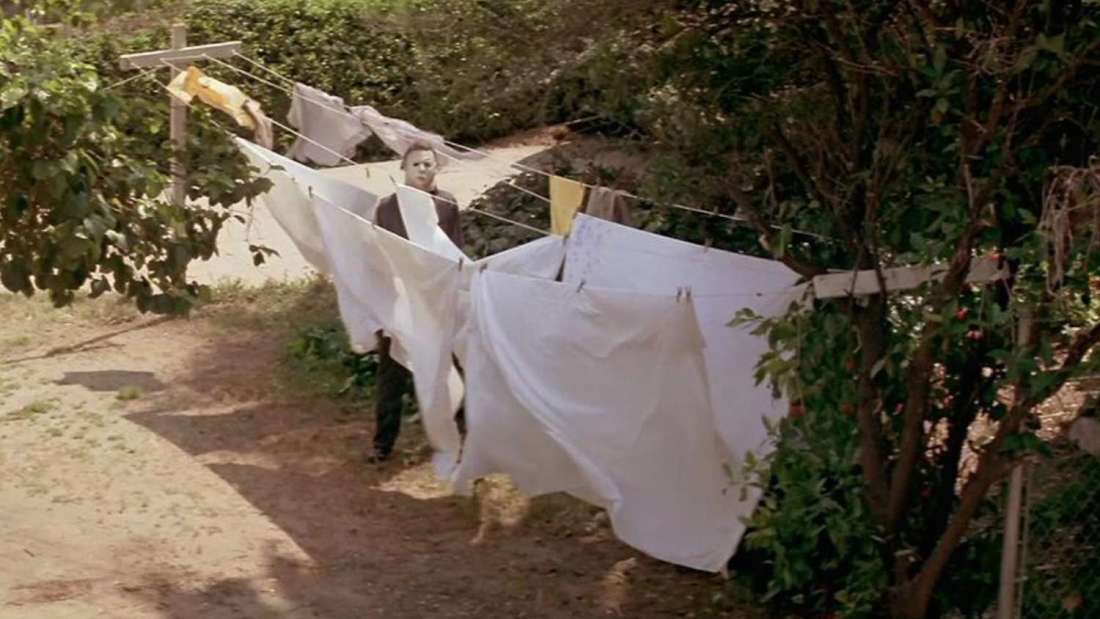Blueprints: "Halloween (1978)"
 Thursday, October 25, 2018 at 10:00PM
Thursday, October 25, 2018 at 10:00PM This week Jorge goes back to Haddonfield in 1978 for the 40th anniversary of a horror classic to look at how the original film establishes its point of view.

Every script has a point of view. Even movies with multiple protagonists, or whose perspectives change from scene to scene, we are experiencing the events through someone’s lens at any given moment; even if that person is not a character, but someone behind the camera guiding us to what we’re supposed to perceive.
But there are movies with a more literal point of view, where what we are seeing is exactly what one of the characters is. A literal POV is used sparingly in movies, but it’s a great tool to get the audience in the mindset and subjective state of a film. The opening of the original Halloween is told entirely through a POV shot, and though it is abandoned quickly, this sets up the dangerous mood and tone of a franchise that's continued for generations...
Halloween
Written by: John Carpenter and Debra Hill
[You can read the full script here.]
Darkness. The main titles bleed into the film, as the camera zooms into a shape that turns out to be a Halloween mask: “It is a large, full-head platex rubber mask,
not a monster or ghoul, but the pale, neutral features of a man weirdly distorted by the rubber.” It’s a mask that would become emblematic. The first thing we see in the movie us what will be following Laurie Strode for decade. It’s its iconography.
“It is night.” We are outside a house. The script indicates that we are watching it through “someone’s POV.” It’s not an outside perspective, the camera is one of the characters. We don’t know who just yet. “Suddenly we hear voices from inside the house.” By using the “we” pronoun on the action lines, Carpenter and Hill immediately link the audience with the camera.

***

The POV “moves slowly” and “peers around.” He is going unnoticed, and we are alongside him. The sequence has a very voyeuristic feel, setting up a tone of paranoia that will characterize the movie throughout. For the rest of it, however, we will experience this feeling of being watched from the other side. Right now, we are the ones watching.
The POV “bends down and picks” the Halloween mask. Puts it on. “Then suddenly the POV is covered by the mask and we see through the eye-holes.” The connection between the audience and character is stronger, closer, and more claustrophobic now.

***

The scene gradually escalates until it climaxes in the inevitable moment we all knew was coming since the POV picked up the knife, and we sat down to watch a horror film. The sister stares at this figure, calling it “Michael.” She knows who this is. Michael “lunges forward” at her, and we experience her murder through the eye holes of this person. It’s not clear exactly what or how this is happening. We just see blurs, and slashes, and blood: “There is a rapid blur as the POV drives the butcher knife into the sister's chest and out again almost before we've seen it.”
Later, the parents of the murdered sister arrive. The father rips off the Halloween mask from us, taking us outside and breaking the POV. We finally get a lot at the person whose head we’ve been inside on for an entire sequence. This is Michael, age six. “A bright-eyed boy with calm, quiet smile on his face.” The camera pulls back after this reveal. Away from Michael. Away from his parents, and the house, and the neighborhood. Into the sky as sirens start to pour in. The movie begins.

***

Literally staying inside a single character’s perspective for the duration of an entire movie would be an exhausting experience. But Halloween effectively uses this technique at the jump to set up the mental state of its antagonists. It builds its tone by recreating the feeling of following someone before recreating the feeling of being followed.
Halloween is, from this opening scene, a master class in tone, mood, tension building and release. It’s a movie that taught generations of horror fans and filmmakers that you don’t need much to get under someone’s skin. All it takes is a rubber mask.



Reader Comments (3)
Thanks for writing this! Debra Hill doesn’t get enough credit for the success of HALLOWEEN. I was at a screening last month with PJ Soles in attendance, and she candidly revealed that everyone on set clearly viewed Hill and Carpenter as co-directors of the film.
One of the best opening sequences ever filmed.
Great analysis.